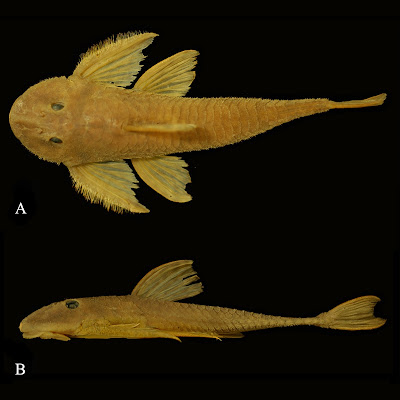 |
| Harttia canastra Caldas, Cherobim & Langeani, 2022 |
Abstract
The genus Harttia belongs to the subfamily Loricariinae and has to date 27 described species, distributed in the drainages of Guiana Shield, Amazon and southeastern Brazil. The new species is distinguished from its congeners by the combination of: canal plate present; abdominal plates absent; trapezoid preanal plates; males with elongated and conspicuous odontodes on the first pectoral-fin ray and on the lateral region of the head, close to the canal plate; and dorsal-fin spinelet present. An identification key for the species of the rio São Francisco basin and a comparison between the new taxon and all other species of the genus are presented.
Keywords: Brazilian Crystalline Shield; Brazilian Plateau; Identification key; Streams; Waterfalls.
Harttia canastra, new species
Diagnosis. The naked abdomen between pectoral- and pelvic-fin girdles readily discriminates Harttia canastra from Harttia absaberi Oyakawa, Fichberg & Langeani, 2013, H. dissidens Rapp Py-Daniel & Oliveira, 2001, H. duriventris Rapp Py-Daniel & Oliveira, 2001, H. fluminensis, H. fowleri (Pellegrin, 1908), H. longipinna, H. panara Oyakawa, Fichberg & Rapp Py-Daniel, 2018, H. punctata Rapp Py-Daniel & Oliveira, 2001, H. rhombocephala, H. rondoni Oyakawa, Fichberg & Rapp Py-Daniel, 2018, H. surinamensis Boeseman, 1971, H. trombetensis Rapp Py-Daniel & Oliveira, 2001, H. tuna, and H. villasboas Oyakawa, Fichberg & Rapp Py-Daniel, 2018 (vs. abdomen partially or completely covered by plates; Figs. 3B,C). Harttia canastra can be distinguished from H. carvalhoi Miranda Ribeiro, 1939, H. garavelloi Oyakawa, 1993, H. intermontana Oliveira & Oyakawa, 2019, H. kronei Miranda Ribeiro, 1908, H. leiopleura, and H. novalimensis by having preanal plates (vs. preanal plates absent; Figs. 3A,D,E). Furthermore, Harttia canastra can be distinguished from H. torrenticola by having two to four large trapezoidal preanal plates and dorsal-fin spinelet present (vs. two to four circular preanal plates and dorsal-fin spinelet absent; Fig. 3F). It differs from Harttia gracilis Oyakawa, 1993 in that its lower and upper caudal rays are of same size (vs. upper ray slightly longer than the lower one). Harttia canastra can be distinguished from H. guianensis Rapp Py-Daniel & Oliveira, 2001, H. loricariformis Steindachner, 1877, and H. uatumensis Rapp Py-Daniel & Oliveira, 2001 by the presence of the dorsal-fin spinelet and by the hypertrophy of odontodes in the lateral region of the head, close to the canal plate, and in the unbranched pectoral fin ray in adult males (vs. absence of the dorsal-fin spinelet and males without hypertrophied odontodes). Distinguished from Harttia depressa by body depth 40.0–66.7% and head depth 35.7–52.6% of HL (vs. extremely depressed body and head, respectively 27.0–33.3% and 31.2–35.7% of HL). It differs from H. merevari by having anterior region of head more rounded, darker coloration and adult males with hypertrophied odontodes (vs. anterior region of head more triangular, light or dark yellow with many spots and males without hypertrophied odontodes). Finally, in relation to the other species of the rio São Francisco basin, H. canastra is distinguished from H. longipinna by the absence of plates in the abdominal region between pectoral- and pelvic-fin girdles and by the equivalent anal-fin length both in males and females (respectively 11.7–18.2% and 11.7–18.7% of SL; vs. partially covered abdomen and anal-fin length longer in males than in females (respectively 20.0–25.0% and 13.9–16.1% of SL; Fig. 3B); from H. leiopleura and H. novalimensis for presenting preanal plates (vs. preanal plates absent; Figs. 3D,E); and from H. torrenticola by having two large preanal trapezoidal plates (vs. two to four circular minute preanal plates; Fig. 3F) and the dorsal-fin spinelet (vs. dorsal-fin spinelet absent).
Etymology. The name “canastra” refers to the Serra da Canastra, a mountain range located in the center-south of the state of Minas Gerais, which houses the headwaters of the rio São Francisco, where most of the specimens were collected. A noun in apposition.
Laís Caldas, Arieli Matheus Cherobim and Francisco Langeani. 2022. A New Species of Harttia from the rio São Francisco basin (Siluriformes: Loricariidae). Neotrop. ichthyol. 20(4); DOI: 10.1590/1982-0224-2022-0051
Resumo: O gênero Harttia pertence à subfamília Loricariinae e possui 27 espécies descritas, distribuídas nas drenagens do Escudo das Guianas, Amazônica e do sudeste brasileiro. A nova espécie distingue-se das congêneres pela combinação de: placa do canal presente; placas abdominais ausentes; placas pré-anais trapezóides; machos com odontódeos alongados e conspícuos no primeiro raio da nadadeira peitoral e na região lateral da cabeça, próximo a placa do canal; e spinelet da nadadeira dorsal presente. Apresenta-se uma chave de identificação para as espécies da bacia do rio São Francisco e a comparação com todas as demais espécies do gênero.
Palavras-chave: Cachoeiras; Chave de identificação; Escudo Cristalino Brasileiro; Planalto Brasileiro; Riachos

